1997 CADILLAC ELDORADO brake
[x] Cancel search: brakePage 15 of 361
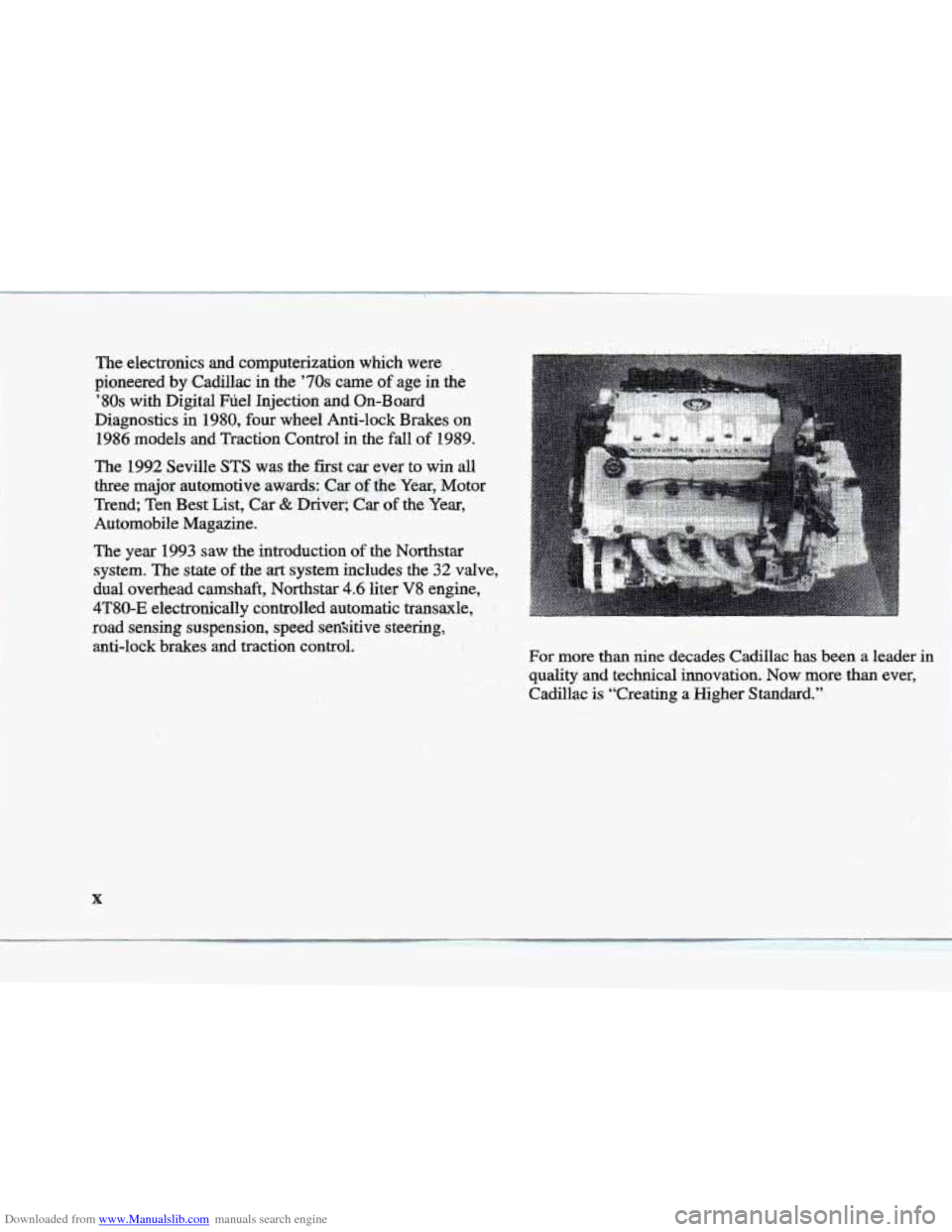
Downloaded from www.Manualslib.com manuals search engine The electronics and computerization which- were
pioneered
by Cadillac in the ’70s came of age in the
’80s with Digital F~el Injection and On-Board
Diagnostics in
1980, four wheel Anti-lock Brakes on
1986 models and Traction Control in the fall of 1989.
The 1992 Seville STS was the fist car ever to win all
three major automotive
awards: Car of the Year, Motor
Trend; Ten Best List, Car & Driver; Car of the Year,
Automobile Magazine.
The
year 1993 saw the introduction of the Northstar
system. The state
of the art system includes the 32 valve,
dual overhead camshaft, Northstar 4.6 liter
V8 engine,
4T80-E electronically controlled automatic transaxle,
road sensing suspension, speed sen3itive steering,
anti-lock brakes and traction control.
5 ’ , 74.. ,,I I..
.. I .: ~~ I , .. * ? ., i L
‘I .;. . 4 ~ , *.’; .L - ; :
, ,‘rr , . I ‘1 ._ i
. ..
For more than nine decades Cadillac has been a leader in j
quality and technical innovation. Now more than ever,
Cadillac is “Creating
a Higher Standard.” I
x
Page 18 of 361
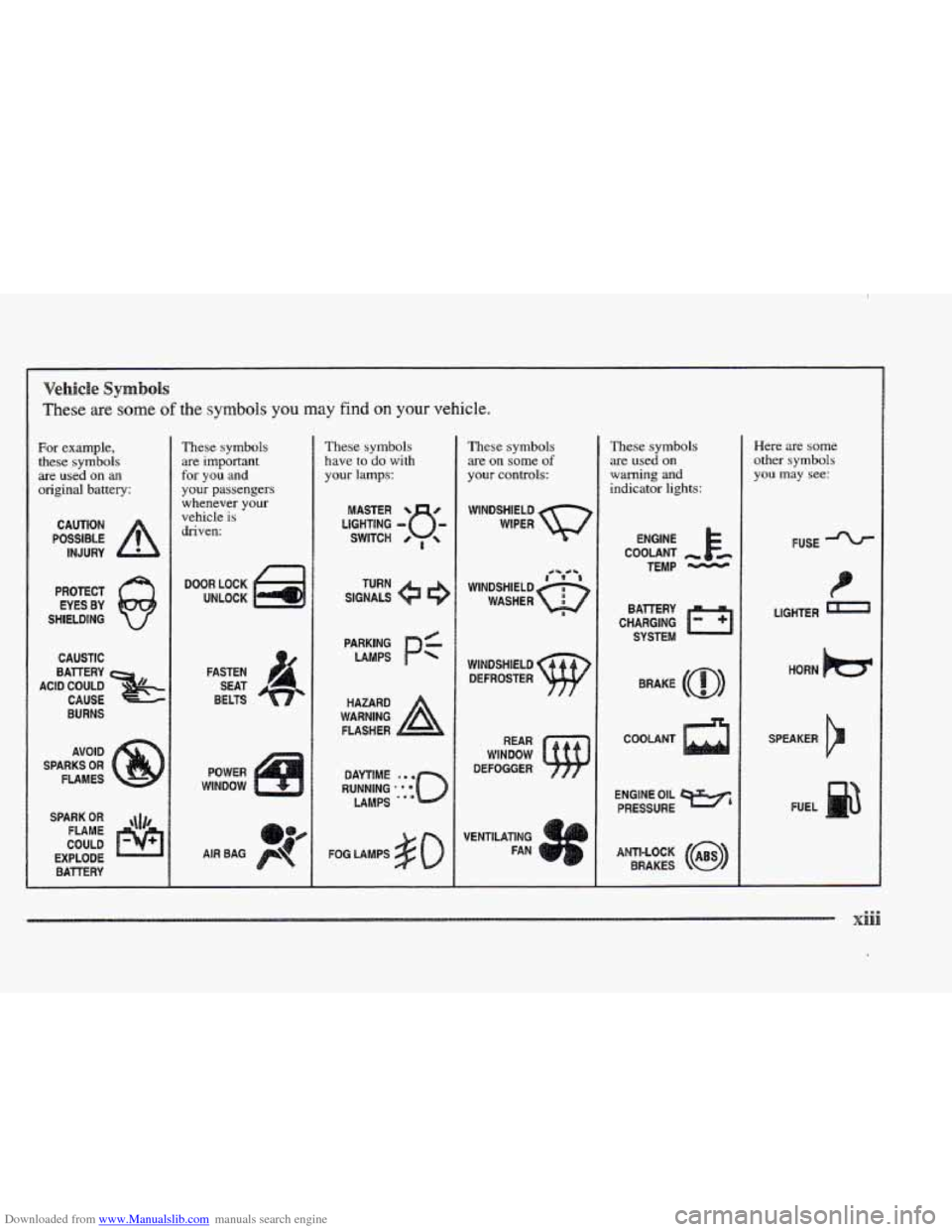
Downloaded from www.Manualslib.com manuals search engine Vehicle Symbo1s
These are some of the symbols you may find on your vehicle.
For example,
these symbols are used on
an
original battery:
CAUTION
POSSIBLE
INJURY
PROTECT EYES BY
SHIELDING
CAUSTIC
BAllERY
ACID COULD CAUSE
BURNS
AVOID
SPARKS OR
FLAMES
SPARK
OR
FLAME
COULD
EXPLODE BATTERY
These symbols
are important
for you and
your passengers
whenever your
vehicle is
driven:
DOOR LOCK
UNLOCK
FASTEN SEAT
BELTS
POWER
WINDOW
These symbols
have to do with
your
lamps:
TURN
SIGNALS
PARKING
/
LAMPS
-
HAZARD
WARNING
FLASHER
DAYTIME . .
RUNNING * *
LAMPS .OB
FOG LAMPS
These symbols
are
on some of
your controls:
WINDSHIELD
WIPER
45 c5
WINDSHIELD
WASHER tea
WINDSHIELD DEFROSTER
REAR
WINDOW
DEFOGGER
VENTILATING
I
FAN W
These symbols
are used on
warning and
indicator lights:
ENGINE
COOLANT
-
TEMP
BAlTERY
CHARGING SYSTEM
BRAKE
COOLANT
ENGINE OIL
PRESSURE
ANTI-LOCK BRAKES
a
Here are some
other symbols
you may
see:
FUSE *
LIGHTER n
HORN
SPEAKER
FUEL
xiii
Page 64 of 361

Downloaded from www.Manualslib.com manuals search engine Here you can leam about the many standard and option,al features on your Cadillac, and information on starting,
shifting
and braking. Also explained are the instrument panel and the warning systems that tell you if everything is
working properly,-- and what to do if you have a problem.
2-2
2-4
2-7.
2- 12
2-15
2- 16
2-18
2- 19
2- 19
2-2 1
2-22
2-23
2-26
2-28 2-3
1
2-3 1
2-32
2-32
Keys
Door Locks
Remote Keyless
Entry (RKE) System
Td
Theft
Theft-Deterrent System (If Equipped)
PASS-Key@
11
New Vehicle “Break-In”
Ignition Positions
Starting
Your Engine
Engine Coolant Heater (Option)
(Canada
Only)
Automatic Transaxle Operation
Parking Brake
Shifting Into
PARK (P)
Shifting Out of PARK (P)
Parking Over Things That Burn
Engine Exhaust
Running
Your Engine While You’re Parked
2-33
2-35
2-42
2-47
2-49
2-55
2-57
2-5 8
2-5 8
2-5 8
2-58
2-59
2-60
2-64
2-66
2-67
2-70
2-8
1
Windows
Turn SignaYMultifunction Lever
Lamps Interior
Lamps
Mirrors
Storage Compartments
Ashtrays and Cigarette Lighter
Cellular Telephone (Option)
Assist
Handles
Garment Hooks
Floor Mats
Astroroof (Option)
Universal Transmitter (Option)
The Instrument Panel:
Your
Information System
Digital Cluster (Eldorado Only)
Analog Cluster (If Equipped)
Warning Lights, Gages and Indicators
Driver Infomation Center
(DIC)
Page 65 of 361
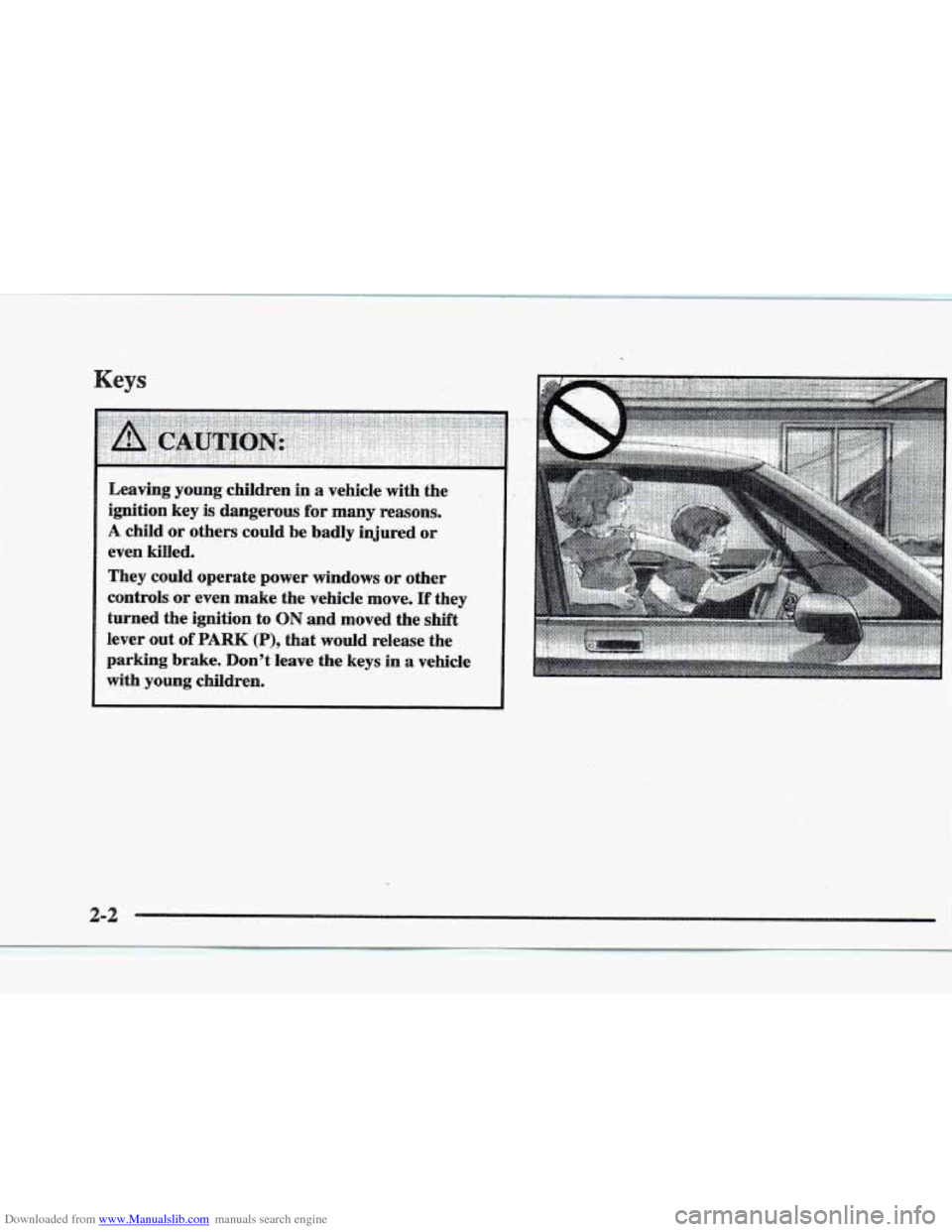
Downloaded from www.Manualslib.com manuals search engine L
Leaving young children in a vehicle with the
ignition key
is dangerous for many reasons.
A child or others could be badly injured or
even killed.
They could operate power windows or other
controls or even make the vehicle move.
If they
turned the ignition to
ON and moved the shift
lever out
of PARK (P), that would release the
parking brake. Don't leave the-keys in a vehicle
with young children.
Page 82 of 361
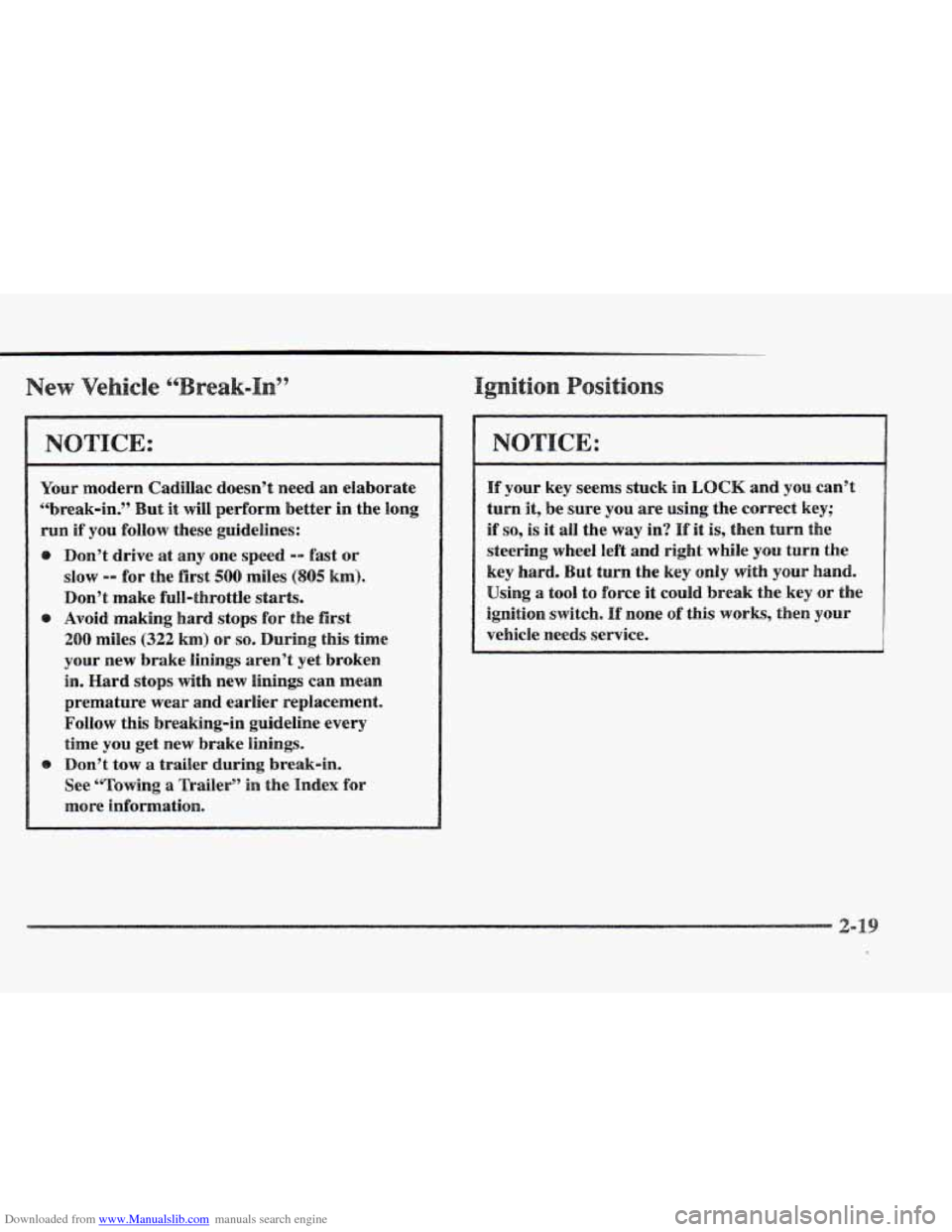
Downloaded from www.Manualslib.com manuals search engine e 99
~~~~~~~~ ~
Your modern Cadillac doesn’t need an elaborate
“break-in? But
it will perform better in the long
run if you follow these guidelines:
cb
Don’t drive at any one speed -- fast or
slow
-- for the first 508 miles ($05 hm).
Don’t make full-throttle starts.
Avoid making hard stops
for the first
200 miles (322 km) or so. During this time
your new brake linings aren’t yet broken
in. Hard stops with new linings can mean
premature wear
and earlier replacement.
Follow this breaking-in guideline every
time you get new brake linings.
Donst tow a trailer during break-in.
See “Towing a Trailer” in the Index for
more
information.
si s
If your key seems stuck in LOCK and YOU canst
turn it, be sure you’are using the correct key;
if so, is it all the way in? If it is, them turn the
steering wheel left and right while
you turn the
bey hard. But turn the key only with your hand.
Using a tool to force it odd break the key OF the
ignition switch.
If none OF this works, then your
vehicle needs service.
Page 86 of 361
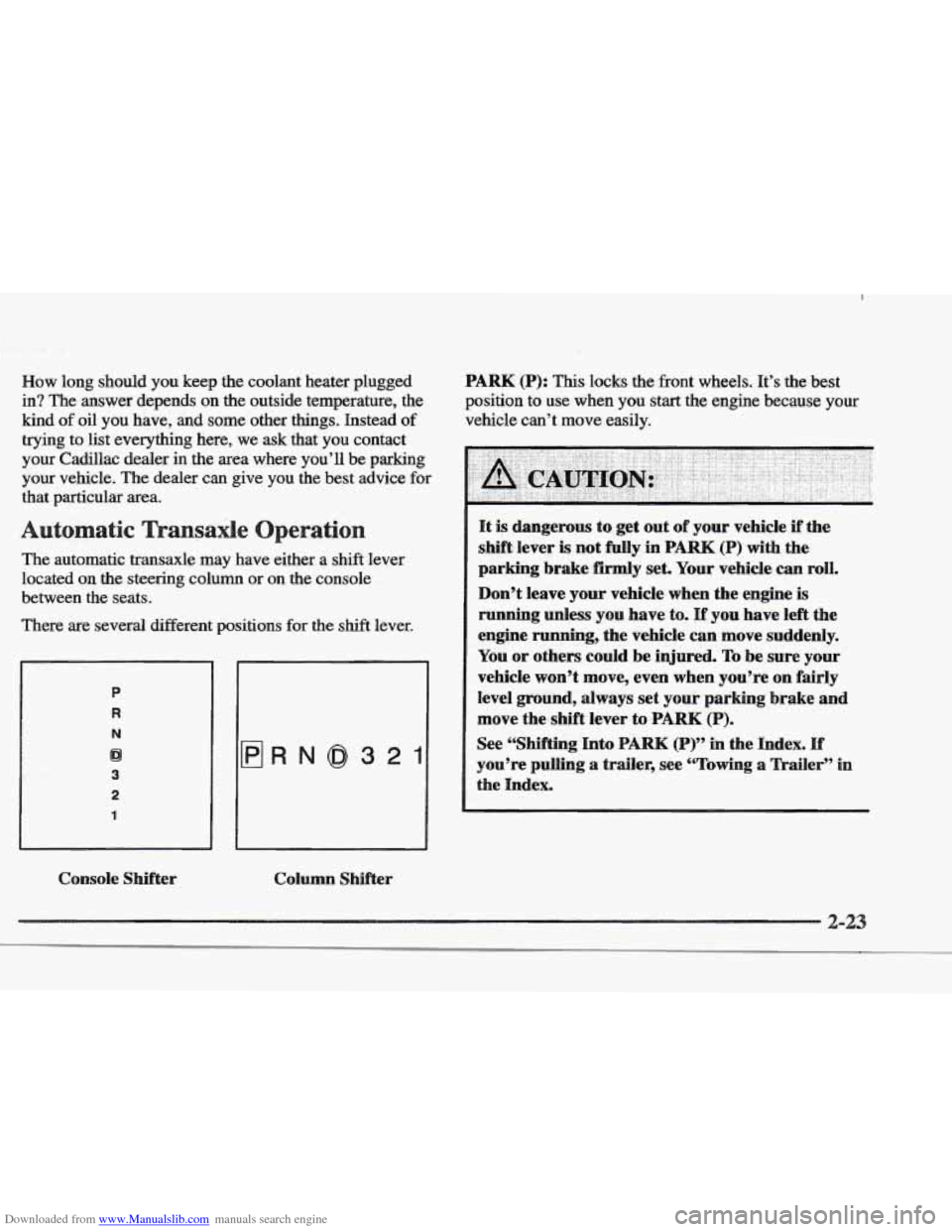
Downloaded from www.Manualslib.com manuals search engine How long should you keep the coolant heater plugged
in? The answer depends on the outside temperature, the
kind
of oil you have, and some other things. Instead of
trying to list everything here, we ask that you contact
your Cadillac dealer in the area where you’ll be parking
your vehicle. The dealer can give you the best advice for
that particular area.
The automatic transaxle may have either a shift lever
located on the steering
column or on the console
between
the seats.
There are several different positions for the
shift lever.
P
R
N
Dl
3
2
1
HRN@321
Console Shifter Collnmn Shifter PARK
(P): This locks
the.front wheels. It’s the best
position to use when you start the engine because your
vehicle can’t move easily.
It is dangerous to get out of your vehicle if the
shift lever
is not fully in PARK (P) with the
parking brake firmly set. Your vehicle
can roll.
Don’t leave your vehicle when the engine
is
running unless you have to. If you have left the
engine running, the vehicle can move suddenly.
You
or others could be injured. To be sure your
vehicle won’t move, even when you’re on fairly
leveI ground, always set your
parking brake and
move the shift lever to
PARK (P).
See “Shifting Into PARK (P)” in the Index. If
you’re pulling a trailer, see “Towing a Trailer” in
the Index.
2-23
Page 87 of 361

Downloaded from www.Manualslib.com manuals search engine Ensure the shift lever is fully in PARK (P) range before
starting the engine.
Your Cadillac has a brake-transaxle
shift interlock.
You have to fully apply your regular
brakes
before you can shift from PARK (P) when the
ignition key is in the RUN position. If you cannot shift
out
of PARK (P), ease pressure on the shift lever -- push
the shift lever all the way
into PARK (P) and release the
shift lever button
QII the floor shift console models as
you maintain brake application. Then move the shift
lever into the gear
you wish. (Press the shift lever button
before moving the shift lever on floor shift console
models.) See “Shifting Out
of PARK (P)” in this section.
EVERSE (It): Use this gear to back up.
Also use this gear to J-QC~ your vehicle back and forth to
get out of snow, ice or sand without damaging your
transaxle. See “If You’re Stuck in Sand, Mud, Ice or
Snow” in the Index for additional information.
NEUTRAL (N): In this position, the engine
doesn’t connect with
the wheels. To restart when you’re
already moving, use
NEUTRAL (N) only. Also, use
NEUTRAL (N) when your vehicle is being towed.
Shifting out of PARK (P) or NEUTWAL (N) while
your engine
is “racing” (running at high speed) is
dangerous. Unless your foot is firmly on the
brake pedal, your vehicle coulld move very
rapidly.
You could lose control and hit people or
objects. Don’t shift
out of PARK (P) or
NEUTRAL (N) while your engine is racing.
Damage to your transaxle caused by shifting out
of PARK (P) or NEWTML (N) with the engine
racing isn’t covered by your warranty.
Page 88 of 361
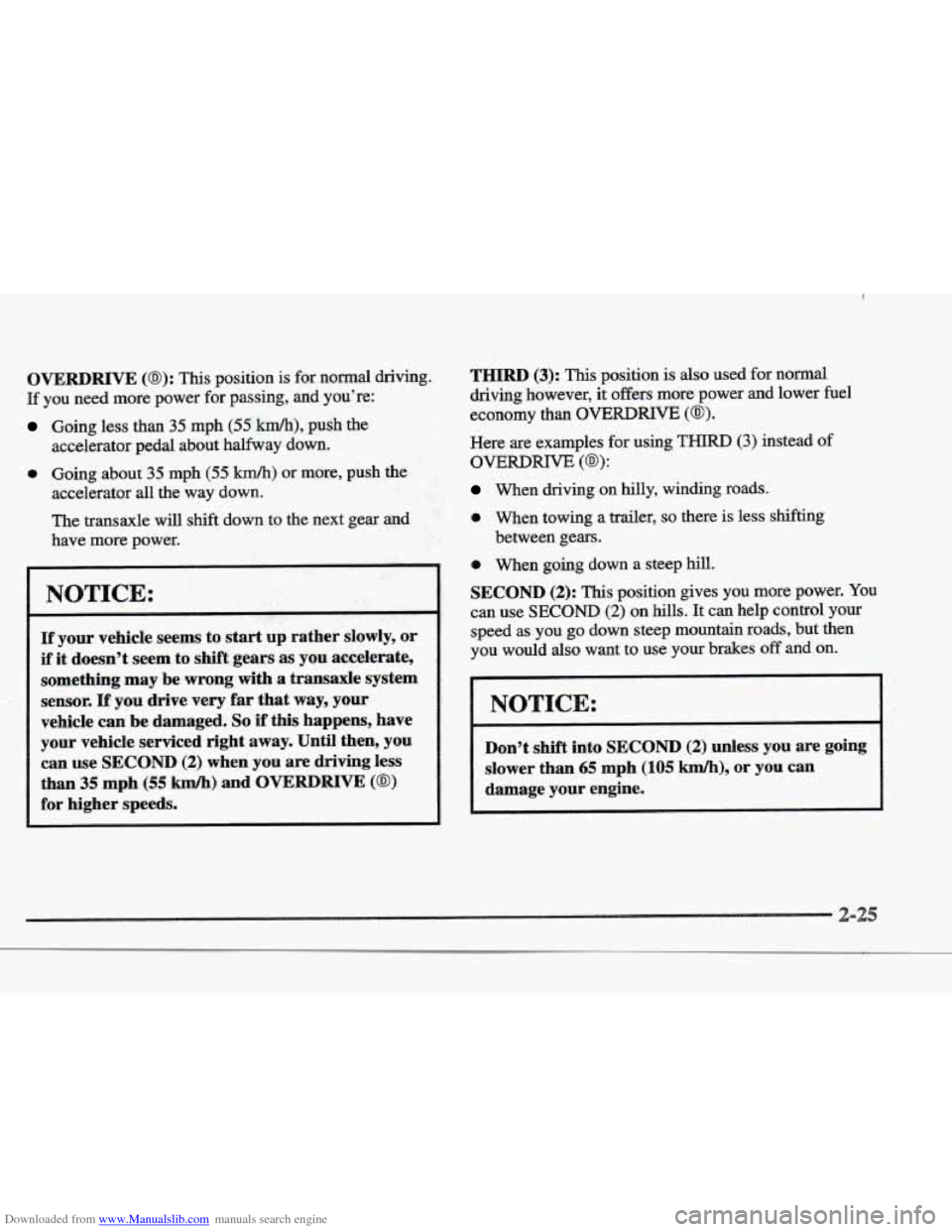
Downloaded from www.Manualslib.com manuals search engine OVERDRIVE (@): This position is for normal driving.
If you need more power for passing, and you’re:
Going less than 35 mph (55 km/h), push the
accelerator pedal about halfivay down.
a Going about 35 mph (55 km/h) or more, push the
accelerator all the way down.
The transaxle will shift down to the next gear and
have more power.
NOTICE:
If your vehicle seems to start up rather slowly, or
if it doesn’t seem to shift gears as YOU accelerate,
something may be wrong with
a transaxle system
sensor.
If you drive very far that way, your
vehicle
can be damaged. So if this happ,ens, have
your vehicle serviced right away. Until then, you
can use SECOND (2) when you are driving less
than
35 mph (55 km/h) and OVERDRIVE (@)
for higher speeds.
THIRD (3): This position is also used for normal
driving however, it offers more power
and lower fuel
economy than OVERDRIVE (GB).
Here are examples for using THIRD (3) instead of
When driving on hilly, winding roads.
0 When towing a trailer, so there is less shihing
0 When going down a steep hill.
SECOND (2): This position gives you more power. You
can use SECOND (2) on hills. It canhelp control your
speed as you
go down,steep mountain roads, but then
you would
also want to use your brakes off and on.
OVERDRIVE (@):
between gears.
Don’t shift into SECOND (2) unless YOU are going
slower
than 65 mph (105 km/h), or you can